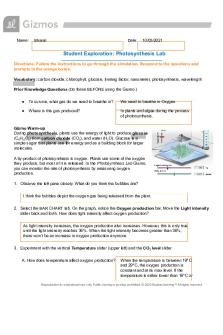Photosynthesis Lab - rreport PDF

| Title | Photosynthesis Lab - rreport |
|---|---|
| Author | Isabella Zagami |
| Course | Biology I/Lab |
| Institution | Nova Southeastern University |
| Pages | 4 |
| File Size | 167.4 KB |
| File Type | |
| Total Downloads | 7 |
| Total Views | 132 |
Summary
rreport...
Description
Isabella Zagami 09/21/20 D09
Average Percent Transmittance of DPIP Over Time (in Minutes) Time (in Unboiled/Dark Unboiled/Light Boiled/Light Minutes) 0 83.35 74.78 119.80 5 91.28 96.90 119.40 10 94.40 99.33 119.48 15 95.55 101.25 119.48
No chloroplasts 125.90 125.90 125.90 125.90
Standard Deviation 25.64 16.86 15.27 14.45
Figure 1 shows the average percent transmittance of DPIP in different conditions of the chloroplasts. One sample the chloroplasts were boiled, killing the chloroplast, which causes photosynthesis to not occur. Another sample had no chloroplasts, so photosynthesis could not occur. That is why the green and purple line is straight at the highest value, since photosynthesis is not taking place. According to the figure, the unboiled chloroplasts in light had the highest average percent transmittance of DPIP
Discussion The conditions that provided the best results would be the unboiled chloroplasts that were incubated in the light. Since the chloroplasts were still alive (since they were not boiled), and
Isabella Zagami 09/21/20 D09 had a light source, so the chloroplasts were still able to go through the process of photosynthesis. Boiled chloroplasts killed the chloroplasts, not allowing them to go through photosynthesis, and if there are no chloroplasts, photosynthesis could not occur. The controls in this experiment would be the amount of phosphate buffer and DPIP added to each cuvette (except blank), and the same source of light was used for the cuvettes. However, one cuvette was covered in foil, so that cuvette did not take in any light. The best condition would be the unboiled chloroplasts incubated in the light, but the worst condition would be the boiled chloroplasts in the light, since the chloroplasts would be dead. This supported my hypothesis because before conducting the experiment, I knew that plants need light to go through photosynthesis, so I figured that the chloroplasts that were not boiled would go through photosynthesis, causing the highest average percent transmittance of DPIP. Lab Notebook Questions 1. The purpose of DPIP is to replace NADP+, which is an electron acceptor. DPIP also changes color when it becomes reduced in the light-dependent reaction of photosynthesis. 2. DPIP replaced the molecule NADP+. 3. The source of electrons that reduced the DPIP would be the chloroplasts 4. The percent transmittance of light of chloroplasts (boiled or unboiled) in light (or no light). 5. The purpose of the beaker of water is to act as a heat sink, meaning that the water is absorbing the heat given off from the light. 6. If green light was the light source no photosynthesis would of occurred because, since chloroplasts are already green, the chloroplasts reflect the green light.
Isabella Zagami 09/21/20 D09 7. The chloroplast that is incubated in the light is able to go through photosynthesis, since light energy is a reactant of photosynthesis. This is why the percent of transmittance is higher in the unboiled/light chloroplasts than the unboiled/dark chloroplasts.
Isabella Zagami 09/21/20 D09
Work Cited: Barbosa, L. C., Demuner, A. J., De Alvarenga, E. S., Oliveira, A., King-Diaz, B., & LotinaHennsen, B. (2006). Phytogrowth- and photosynthesis-inhibiting properties of nostoclide analogues. Pest Management Science, 62(3), 214-222. https://doi.org/10.1002/ps.1147 Morales, R., Charon, M., Kachalova, G., Serre, L., Medina, M., Gómez‐Moreno, C., & Frey, M. (2000). A redox‐ dependent interaction between two electron‐ transfer partners involved in photosynthesis. EMBO reports, 1(3), 271-276. https://doi.org/10.1093/emboreports/kvd057...
Similar Free PDFs

Photosynthesis Lab - rreport
- 4 Pages

Photosynthesis Lab
- 8 Pages

Photosynthesis Lab Report
- 6 Pages

Lab 7 Photosynthesis
- 5 Pages

Photosynthesis Lab Gizmo Answers
- 5 Pages

AP Bio Photosynthesis Lab
- 1 Pages

Photosynthesis Lab - Assignment
- 5 Pages

Photosynthesis Lab SE - Gizmo
- 6 Pages

Lab 7 - Photosynthesis
- 7 Pages

Photosynthesis Lab report
- 8 Pages

Photosynthesis Lab Report 2
- 3 Pages

Photosynthesis lab - summarize
- 4 Pages
Popular Institutions
- Tinajero National High School - Annex
- Politeknik Caltex Riau
- Yokohama City University
- SGT University
- University of Al-Qadisiyah
- Divine Word College of Vigan
- Techniek College Rotterdam
- Universidade de Santiago
- Universiti Teknologi MARA Cawangan Johor Kampus Pasir Gudang
- Poltekkes Kemenkes Yogyakarta
- Baguio City National High School
- Colegio san marcos
- preparatoria uno
- Centro de Bachillerato Tecnológico Industrial y de Servicios No. 107
- Dalian Maritime University
- Quang Trung Secondary School
- Colegio Tecnológico en Informática
- Corporación Regional de Educación Superior
- Grupo CEDVA
- Dar Al Uloom University
- Centro de Estudios Preuniversitarios de la Universidad Nacional de Ingeniería
- 上智大学
- Aakash International School, Nuna Majara
- San Felipe Neri Catholic School
- Kang Chiao International School - New Taipei City
- Misamis Occidental National High School
- Institución Educativa Escuela Normal Juan Ladrilleros
- Kolehiyo ng Pantukan
- Batanes State College
- Instituto Continental
- Sekolah Menengah Kejuruan Kesehatan Kaltara (Tarakan)
- Colegio de La Inmaculada Concepcion - Cebu



